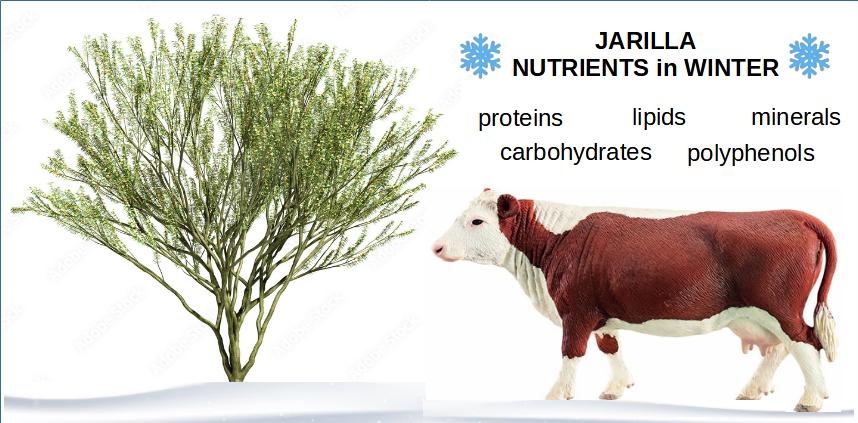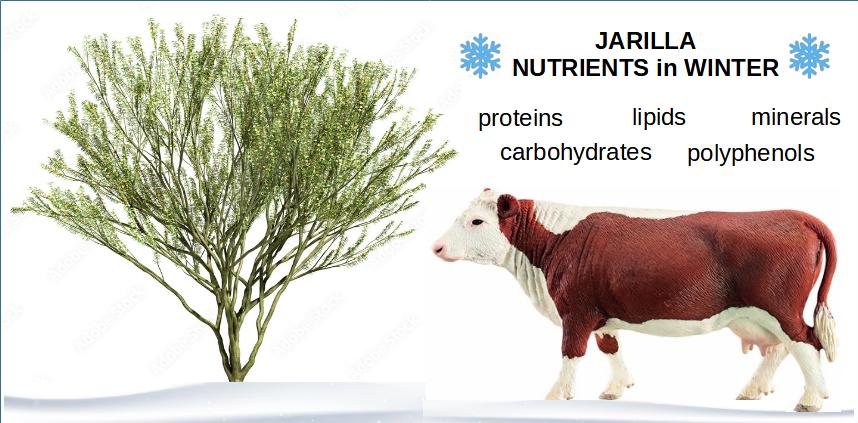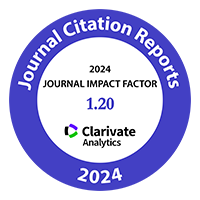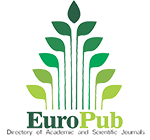Nutritional characterization of Larrea divaricata Cav during winter and its potential as cattle and goats feed
DOI:
https://doi.org/10.48162/rev.39.160Palabras clave:
planta nativa, arbusto, jarilla, rumiante, desierto, forrajeResumen

The ever-increasing global demand for agricultural commodities and progressive climate change factors are displacing extensive beef cattle and goat ranching from temperate humid regions to peripheral regions with semi-arid characteristics. Extensive investigation is required on native desert plants to be safely incorporated into feed programs and to maintain the biodiversity and sustainability of these fragile ecosystems. Larrea divaricata is a native plant adapted to arid and semi-arid biomes of South and Western-South America. This research evaluates the nutritional composition of the browsing available canopy parts of Larrea divaricata during the winter season in a semi-arid region of Argentina. Its crude protein content resulted in 11.20% of dried matter and its soluble protein content resulted in nearly 80% of the crude protein. Acid detergent fiber fraction, ash-corrected neutral detergent fiber fraction, lignin, ash content, fat-like compounds, and non-fibrous carbohydrates resulted in 17.42, 35.51, 12.09, 9.96, 5.92 and 3.82% of dried matter, respectively. Essential bioelements Ca, Mg and K resulted within standard forage requirements. Total polyphenols and flavonoids resulted in 430 mg/g and 140 mg/g, respectively. These results demonstrate that Larrea divaricata can be an effective complement for winter-feeding beef cattle and goats in arid and semi-arid regions.
Highlights:
- Larrea divaricatacan be an effective complement for winter-feeding beef cattle and goats in arid and semi-arid regions.
- Crude protein and carbohydrates resulted in 11.20% and 9.74% of dried matter, respectively.
- Essential bioelements resulted within standard forage requirements.
Descargas
Citas
AOAC 965. 2017. www.eoma.aoac.org/methods/info.asp?ID=33502 (accessed 19 January 2023)
Bandoni, A. L.; Mendiondo, M. E.; Rondina, V. D.; Coussio, J. D. 1972. Survey of Argentina medicinal plants I: Folklore and phytochemical screening. Lloydia. 35: 69-80. https://pubmed.ncbi. nlm.nih.gov/4402573/
BCR. 2022. Agricultura en Argentina Panorama [2022]. https://surdelsur.com/es/agricultura-argentina/ (accessed 19 January 2023)
Boiteux, J.; Fernández, M. de los Á.; Espino, M; Silva, M. F.; Pizzuolo, P. H.; Lucero, G. S. 2023. In vitro and in vivo efficacy of Larrea divaricata extract for the management of Phytophthora palmivora in olive trees Revista de la Facultad de Ciencias Agrarias. Universidad Nacional de Cuyo. Mendoza. Argentina. 55(2): 97-107. DOI: https://doi.org/10.48162/rev.39.112
Bruneton, J. 2001. Farmacognosia. Fitoquímica. Plantas medicinales. 2nd ed. Acribia.
Diaz, R. O. 2007. Utilización de pastizales naturales. Brujas.
Duisburg, P. D. 1952. Desert plant utilization. Texas Journal of Science. 4: 269-283.
FAO. 2022. The state of agricultural commodity markets 2022. The geography of food and agricultural trade: Policy approaches for sustainable development. FAO. https:// doi.org/10.4060/cc0471en
GAFTA 3. 2014. www.gafta.com/write/MediaUploads/Contracts/2014/method_3.0_2014.pdf (accessed 19 January 2023)
GAFTA 4. 2003 www.gafta.com/write/MediaUploads/Contracts/2010/4.0_CRUDE_PROTEIN.pdf (accessed 19 January 2023)
GAFTA 11. 2014. www.gafta.com/write/MediaUploads/Contracts/2014/method_11.0_2014. pdf (accessed 19 January 2023)
GAFTA 14. 2003. www.gafta.com/write/MediaUploads/Contracts/2012/14.0_SAND_ONLY_ (SAND_WITHOUT_SILICA).pdf (accessed 19 January 2023)
Galindo, J.; Delgado, D.; Pedraza, R. 2005. Impacto de los árboles, los arbustos y otras leguminosas en la ecología ruminal de animales que consumen dietas fibrosas. Pastos y Forrajes. 28: 59-68. https://www.redalyc.org/articulo.oa?id=269121628005
Garcia, E. M.; Cherry, N.; Lambert, B. D.; Muir, J. P.; Nazareno, M. A.; Arroquy, J. I. 2017. Exploring the biological activity of condensed tannins and nutritional value of tree and shrub leaves from native species of the Argentinean Dry Chaco. Journal of the Science of Food and Agriculture. 97: 5021-5027. htps://doi.org/10.1002/jsfa.8382
Garcia, E.; Lopez, A.; Zimerman, M.; Hernandez, O.; Arroquy, J.; Nazareno, M. 2019. Enhanced oxidative stability of meat by including tannin-rich leaves of woody plants in goat diet. Animal Bioscience. 32: 1439-1447. https://doi.org/10.5713/ajas.18.0537
Goering, H.; Van Soest, P. J. 1970. Forage fiber analysis: Apparatus, reagents, procedures and some applications, in Agricultural Handbook. U.S.D.A. Agricultural Research Service. Vol 379: 76-80.
Goeser, J. P.; Combs, D. K. 2009a. An alternative method to assess 24-h ruminal in vitro NDF digestibility. Journal of Dairy Science. 92: 3833-3841. https://doi.org/10.3168/ jds.2008-1136
Goeser, J. P.; Hoffman, P. C.; Combs, D. K. 2009b. Modification of a rumen fluid priming technique for measuring in vitro NDF digestibility. Journal of Dairy Science. 92: 3842-3848. https:// doi.org/10.3168/jds.2008-1745
Golder, H. M.; Celi, P.; Lean, I. J. 2014. Ruminal acidosis in a 21-month-old Holstein heifer. Canadian Veterinary Journal. 55: 559-564. https://pubmed.ncbi.nlm.nih.gov/24891639/
Hunziker, J. H. 2005. Zygophyllaceae. Flora Fanerogámica Argentina. A.M. Anton & F.O. Zuloaga. 95: 1-20.
ISO 5983. 2005. www.iso.org/standard/39160.html (accessed 19 January 2023)
ISO 5984. 2002. www.iso.org/standard/37272.html (accessed 19 January 2023)
ISO 6492. 1999. www.iso.org/standard/12865.html (accessed 19 January 2023)
ISO 6869. 2000. www.iso.org/standard/33707.html (accessed 19 January 2023)
ISO 13906. 2008. www.iso.org/standard/43032.html (accessed on 19 January 2023)
ISO 16472. 2006. www.iso.org/standard/37898.html (accessed on 19 January 2023)
Kiesling, R. 2003. Flora de San Juan República Argentina. Estudio Sigma.
Lobell, D. B.; Burke, M. B.; Tebaldi, C.; Mastrandrea, M. D.; Falcon, W. P.; Naylor, R. L. 2008. Prioritizing climate change adaptation needs for food security in 2030. Science. 319: 607-610. http://dx.doi.org/10.1126/science.1152339
Mabry, T. J.; Difeo, D. R.; Sakakibara, J. R.; Bohnstedt, C. F.; Seigler, D. 1977. The natural products chemistry of Larrea creosote bush. In: Mabry, T. J.; Hunziker, J. H.; Di Feo, D. R. Jr (Eds.). Biology and Chemistry of Larrea in New World Deserts. Stroudsburg. p. 115-134.
Martino, R. F.; Alonso, M. R.; Anesini, C. A. 2013. Larrea divaricata Cav una planta con gran potencial en fitoterapia. BIFASE. 26: 45-52. http://hdl.handle.net/11336/8519
Mezoughem, C. 2023. Livestock and poultry: World markets and trade. world production, markets, and trade report. https://www.fas.usda.gov/data/livestock-and-poultry-world-markets-and-trade (accessed 19 January 2023)
Mills, S.; Bone, K. 2005. Chaparral. In: Duncan, L. (Ed.). The essential guide to herbal safety. Elsevier Health Sciences. p. 329-330.
Min, B. R.; Pinchak, W. E.; Anderson, R. C.; Fulford, J. D.; Puchala, R. 2006. Effects of condensed tannins supplementation level on weight gain and in vitro and in vivo bloat precursors in steers grazing winter wheat. Journal of Animal Science. 84: 2546-2554. https://doi. org/10.2527/jas.2005-590
Nasif, C. 2007. El nuevo mapa ganadero. SuperCampo. 11(29). https://www.produccion-animal. com.ar/informacion_tecnica/origenes_evolucion_y_estadisticas_de_la_ganaderia/49- mapa_ganadero.pdf (accessed 19 January 2023)
NRC. 2001. Nutrient Requirements of Dairy Cattle. 7th ed. The National Academies Press. https://doi.org/10.17226/9825.
Preston, T. R.; Leng, R. A.; Sangkhom, I.; Gomez, M. E. 2021. The rumen in vitro incubation system as a tool for predicting the nutritive value of ruminant diets and the associated emissions of methane. Livestock Research for Rural Development. 33(6): 74. http://www.lrrd.org/ lrrd33/6/3374prest.html
Ramirez, M. R.; Schnorr, C. E.; Feistauer, L. B.; Apel, M.; Henriques, A. T.; Moreira, J. C. F.; Zuanazzi, J. A. S. 2012. Evaluation of the polyphenolic content, anti-inflammatory and antioxidant activities of total extract from Eugenia pyriformes Cambess (Uvaia) fruits. Journal of Food Biochemistry. 36: 405-412. https://doi.org/10.1111/j.1745-4514.2011.00558.x
Ramirez, M. R.; Mohamad, L.; Alarcon-Segovia, L. C.; Rintoul, I. 2022. Effect of processing on the nutritional quality of Ilex paraguariensis. Applied Sciences. 12(5): 2487. https://doi. org/10.3390/app12052487
Ramos, G.; Frutos, P.; Giraldez, F. J.; Mantecon, A. R. 1998. Plants secondary compounds in herbivores nutrition. Archivos de Zootecnia. 47: 597-620. https://dialnet.unirioja.es/ servlet/articulo?codigo=277645
Rosales, M.; Gill M. 1997. Tree mixtures within integrated farming systems. Livestock Research for Rural Development. 9: 36. http://www.lrrd.org/lrrd9/4/mauro941.htm
Rossi, C. A.; Pereyra, A. M.; Gonzalez, G. L.; De-Leon, M.; Chagra-Dib, P. 2008. Composición química, contenido de polifenoles totales y valor nutritivo en especies de ramoneo del sistema silvopastoril del Chaco árido argentino. Zootecnia Tropical. 26: 105-115. http:// ve.scielo.org/scielo.php?script=sci_arttext&pid=S0798-72692008000200004&lng=es& nrm=iso
Sniffen, C. J.; O’Connor, J. D.; Van-Soest, P. J.; Fox, D.; Russel, J. 1992. A net carbohydrate and protein system for evaluating cattle diets: II Carbohydrate and protein availability. Journal of Animal Science. 70: 3562-3577. https://doi.org/10.2527/1992.70113562x
Stritzler, N. P.; Petruzzi, H. J.; Frasinelli, C. A.; Veneciano, J. H.; Ferri, C. M.; Viglizzo, E. F. 2007. Variabilidad climática en la Región Semiárida Central Argentina. Adaptación tecnológica en sistemas extensivos de producción animal. Revista Argentina de Producción Animal. 27: 111-123. https://repo.unlpam.edu.ar/handle/unlpam/6874
Tedeschi, L. O.; Ramírez-Restrepo, C. A.; Muir, J. P. 2014. Developing a conceptual model of possible benefits of condensed tannins for ruminant production. Animal. 8: 1095-1105. https://doi.org/10.1017/S1751731114000974
Van Soest, P. J. 1990. Use of detergents in the analysis of fibrous feeds: 2. A rapid method for the determination of fiber and lignin. Journal of the Association of the Official Analytical Chemists. 73: 491-497. https://doi.org/10.1093/jaoac/73.4.491
Van Soest, P. J.; Robertson, J. B.; Lewis, B. A. 1991. Methods for dietary fiber, neutral detergent fiber, and non-starch polysaccharides in relation to animal nutrition. Journal of Dairy Science. 74: 3583-3597. https://doi.org/10.3168/jds.S0022-0302(91)78551-2
Weiss, W. P.; Conrad, H. R.; Pierre, N. R. S. 1992. A theoretically based model for predicting total digestible nutrient values of forages and concentrates. Animal Feed Science and Technology. 39: 95-110.

Descargas
Publicado
Cómo citar
Número
Sección
Licencia
Derechos de autor 2018 Revista de la Facultad de Ciencias Agrarias UNCuyo

Esta obra está bajo una licencia internacional Creative Commons Reconocimiento-NoComercial-CompartirIgual 3.0.
Aquellos autores/as que tengan publicaciones con esta revista, aceptan las Políticas Editoriales.












.jpg)




